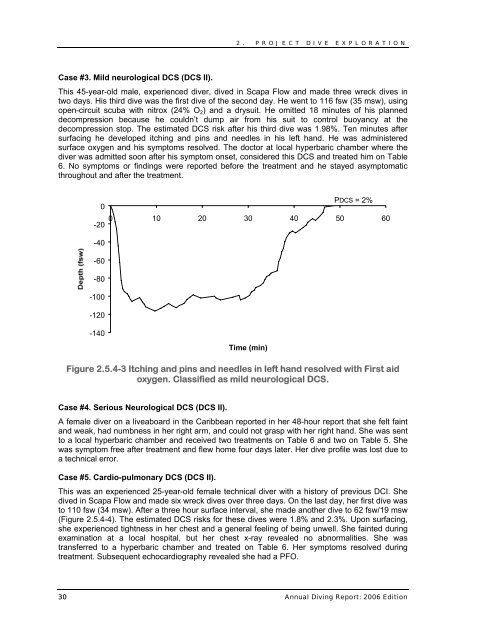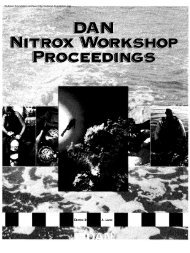Annual Diving Report - Divers Alert Network
Annual Diving Report - Divers Alert Network
Annual Diving Report - Divers Alert Network
You also want an ePaper? Increase the reach of your titles
YUMPU automatically turns print PDFs into web optimized ePapers that Google loves.
Case #3. Mild neurological DCS (DCS II).<br />
2. PROJECT DIVE EXPLORATION<br />
This 45-year-old male, experienced diver, dived in Scapa Flow and made three wreck dives in<br />
two days. His third dive was the first dive of the second day. He went to 116 fsw (35 msw), using<br />
open-circuit scuba with nitrox (24% O2) and a drysuit. He omitted 18 minutes of his planned<br />
decompression because he couldn’t dump air from his suit to control buoyancy at the<br />
decompression stop. The estimated DCS risk after his third dive was 1.98%. Ten minutes after<br />
surfacing he developed itching and pins and needles in his left hand. He was administered<br />
surface oxygen and his symptoms resolved. The doctor at local hyperbaric chamber where the<br />
diver was admitted soon after his symptom onset, considered this DCS and treated him on Table<br />
6. No symptoms or findings were reported before the treatment and he stayed asymptomatic<br />
throughout and after the treatment.<br />
0<br />
0 10 20 30 40 50 60<br />
-20<br />
-40<br />
-60<br />
-80<br />
-100<br />
-120<br />
-140<br />
Time (min)<br />
PDCS = 2%<br />
Figure 2.5.4-3 Itching and pins and needles in left hand resolved with First aid<br />
oxygen. Classified as mild neurological DCS.<br />
Case #4. Serious Neurological DCS (DCS II).<br />
A female diver on a liveaboard in the Caribbean reported in her 48-hour report that she felt faint<br />
and weak, had numbness in her right arm, and could not grasp with her right hand. She was sent<br />
to a local hyperbaric chamber and received two treatments on Table 6 and two on Table 5. She<br />
was symptom free after treatment and flew home four days later. Her dive profile was lost due to<br />
a technical error.<br />
Case #5. Cardio-pulmonary DCS (DCS II).<br />
This was an experienced 25-year-old female technical diver with a history of previous DCI. She<br />
dived in Scapa Flow and made six wreck dives over three days. On the last day, her first dive was<br />
to 110 fsw (34 msw). After a three hour surface interval, she made another dive to 62 fsw/19 msw<br />
(Figure 2.5.4-4). The estimated DCS risks for these dives were 1.8% and 2.3%. Upon surfacing,<br />
she experienced tightness in her chest and a general feeling of being unwell. She fainted during<br />
examination at a local hospital, but her chest x-ray revealed no abnormalities. She was<br />
transferred to a hyperbaric chamber and treated on Table 6. Her symptoms resolved during<br />
treatment. Subsequent echocardiography revealed she had a PFO.<br />
30 <strong>Annual</strong> <strong>Diving</strong> <strong>Report</strong>: 2006 Edition

















